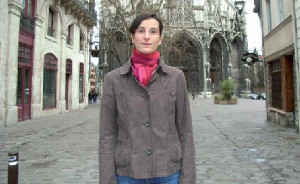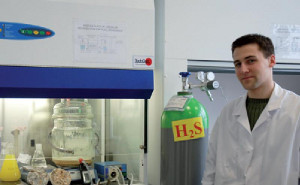M2 MAPE: Materials of cultural heritage in the built environment
The MAPE program trains specialists to address problems associated with the degradation of materials contained in cultural and built heritage exposed to the outdoor environment (whether natural surroundings or an urbanized setting) or to the indoors (e.g. museums, archives, libraries).
Target population :
- Graduates of university degree programs (4-year Maîtrise or Master's 1 in Environmental Sciences, Earth Sciences, Physical Chemistry, Chemistry, Biology or Materials Engineering from a Technical School)
- Engineering students (from schools such as ENSIACET, ISIM, ENS, ESTP, ENPC or INSA)
Upon completion of the second-year Master's (M2) program
Project Manager, Research Specialist, or Design Engineer working in :
- Companies or consulting offices specialized in preliminary design studies for an architectural heritage restoration project
- Local and regional authorities, or private-sector laboratories affiliated with large industrial groups
Following a Ph.D. degree
R&D Engineer, Project Supervisor, Research Professor, Researcher in either the public or private sector.
|
|
R&D design engineer (working with organizations like BnF, CRCC, EPFL, CEA, CSTB, Maturispaints, Concret IdF, Isover, INP) |
|
|
Lead Project Engineer (e.g. GINGER-CEBTP, ECMH, Stonevox, Brizot Masse Engineering, Bateg, LERM, BPE Engineering) |
|
|
Doctoral student-Researcher (Universities, Lafarge, CEA, IFSTTAR, LRMH) |
|
|
Civil service (librarian, museum curator, teacher) |
| The Lead Project Engineer: designs and coordinates projects; manages budget line items; and informs, advises and assists project owners facing challenges related to material sustainability. |
| The Design Engineer lays out and develops new processes for analyzing degraded materials, in addition to improving existing materials already in use. |
| The Doctoral student-Researcher conceives and implements scientific research activities to better understand material alteration mechanisms and moreover disseminates his/her research findings. |

While studying at the ESTP Engineering School, I enrolled in the MAPE Master's program to gain greater awareness of the techniques that protect building materials. During this year of coursework, I grasped the complexity surrounding the detection of material alterations and practiced applying a number of building preservation methods. I fully expect to use this knowledge in my post as construction engineer with the BATEG firm, in their rehabilitation department.
Mathilde R.

As a student at the University of Eastern Paris-Créteil (UPEC), I selected the MAPE major for its wide array of instruction in the areas of materials, the environment and diagnostic evaluations. I acquired quite a multidisciplinary view that proved essential to completing my thesis, under the supervision of the IFSTTAR Institute, on the biodegradation of concrete within drainage networks. I'm presently employed as an R&D Engineer with Kerneos.
Jean H.
Description of the academic program
First semester :
- Agents promoting major alterations (climate, pollution, biosphere)
- Construction materials (stone, glass, metal, wood and concrete)
- Physical chemistry of the given material alteration
- Preservation methods
- Field study of landmark buildings
- Broad selection of lab and discussion sections devoted to analytical techniques and data analysis
- International conferences (historical preservation and sustainable development)
Second semester :
Full-time internship (in a company or laboratory) lasting at least 5 months./p>
Examples of internships conducted in a laboratory or company setting
| Identification of pollution present in the lining of instruments kept in a playable state: Quantitative approach | Music Museum |
| Effect of atmospheric particle deposits on environmental sensors | Conservare / LISA |
| Evaluation and comparison of various microstructural parameters in limestone and sandstone exposed to freeze-thaw action | LCPC / LRMH |
| Characterization of the atmospheric alteration of Medieval-type model glasses | LISA / LRMH |
| Environmental influence on the natural aging of paper soaked in iron gall ink | CRCC |
| Optimization of the dechlorination process applied to iron archaeological objects | CEA |
| Study of the biodegradation mechanisms in concrete drainage facilities | LCPC / G2I |
| Preservation of wooden archaeological objects extracted from submarine digs: Characterization of iron-sulfur compounds | LEMMA / Arc’Nuclear |
| Spectral characterization by the emission and transmission of surface coatings in the far infrared range: Application to an analysis of wall paints | LEEE / LRMH |
| Physicochemical, microstructural and mechanical properties of composite mortars used for repairing civil engineering structures | LCPC |
| The role and function of project manager with GINGER CEBTP | GINGER - CEBTP |
| Evaluation of corrosion in both the atmosphere and stone from 18th-century metal reinforcements placed on the Orléans Cathedral | SCCME/LECBA, SIS2M/LAPA, CEA/CNRS |
| Creation of a health report on the stables once held by the Maréchal de Saxe | CRMD |
| Preliminary studies leading to the restoration of materials in buildings and monuments | TOLLIS |
| Determination of the influence exerted by an end-of-life scenario on the environmental assessment of wooden structures | École des Ponts ParisTech |
| Study of the VOC released by cardboard packaging and its effects on the cellulose of paper documents | BnF |
| Rating of protection systems designed for copper statues | LRMH |
| Evaluation of alternative materials for green concretes | IFSTTAR - University of Sherbrooke (Quebec) |
| Study of the corrosiveness of volatile organic compounds emitted by the glazing of glass panes in museums on lead, copper and silver | University of Barcelona (Spain) |
| Inventory of integrated solar energy systems installed on existing buildings | Saint-Gobain (Aubervilliers) |
| Role of the environment in the darkening of white lead-based paints | CICRP |
| Determination and enhancement of the sustainability of an ecological material | IRC-ESTP |
| Corrosion diagnosis by means of electrochemical methods | IFSTTAR |
| Laser cleaning and electrochemical techniques applied to building preservation | University of Vienna (Austria) |
| Use of a thermal camera in performing structural assessments | STONEVOX |
| Analyses of the physicochemical mechanisms involved in the formation of gold nanoparticles at the surface of ivory objects | LAMS |
| Characterization of sulfur phases stemming from the corrosion of ferrous archaeological analogues within an anoxic medium | CEA |
| New strategies in metal structure preservation using corrosion inhibitor coatings made from vegetable oil derivatives | C2RMF – SYNCHROTRON SOLEIL |
 |
Academic Program Head | Anne CHABAS |
 |
Secretary's Office | Iveta SAID |
 |
Students' blog | |







